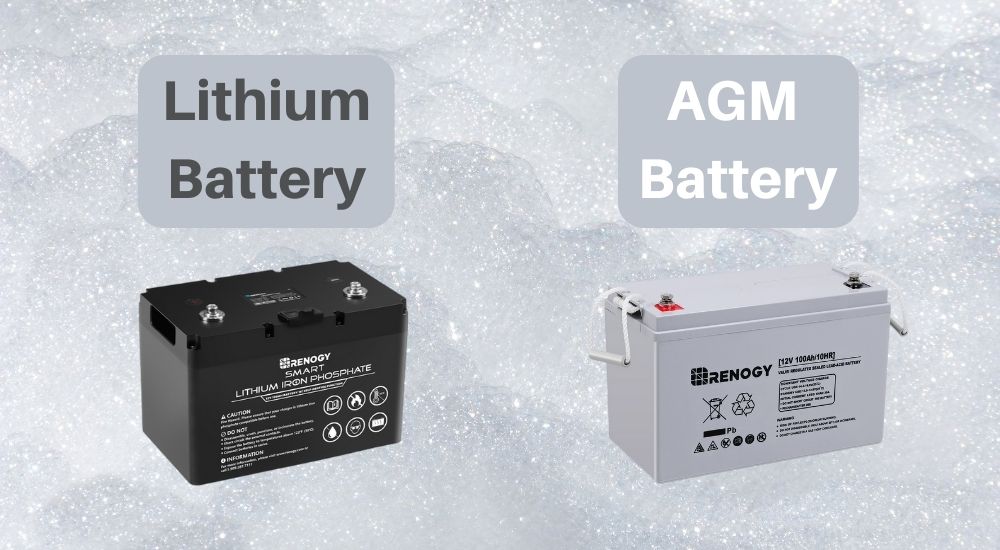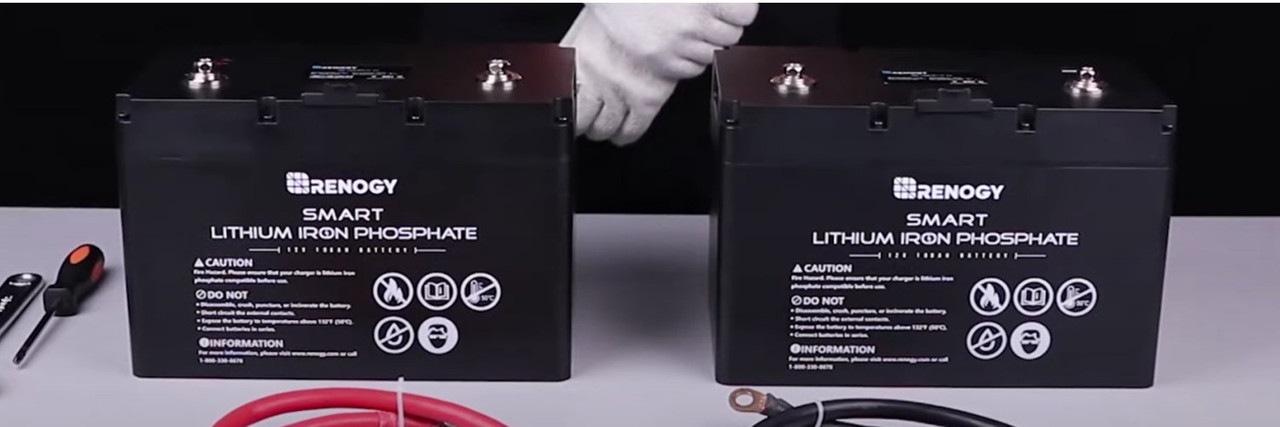Choosing The Best Solar Battery: AGM vs. Lithium Battery
Choosing The Best Solar Battery: AGM vs. Lithium Battery
Do you have solar panels on your roof and often have to use electricity from the grid?
Or perhaps you’re planning to get off the grid for a while while travelling in your RV, and want to make sure you can store energy for the rainy days?
Even though adding a battery to your solar system can be pricey, it’s well worth the investment.
Why?
Because solar batteries can store energy, helping you power your RV or home when the sun isn’t shining or when the power is out. We have another article to tell you more: Is solar batteries worth the cost?
Now, AGM (absorbed glass mat) and lithium batteries are two of the most popular types of solar batteries.
But what is better: lithium or AGM batteries?
In this post, we answer this question to help you make an informed decision and choose the best type of solar battery for your needs.

What Is An AGM Battery?
AGM batteries are the newest category of lead-acid batteries. They are well suited to solar because they require very little to no maintenance. AGM batteries differ from other batteries in that the electrolyte liquid (called battery acid) is absorbed into a woven fiberglass mat instead of being free-floating.
What Is A Lithium Battery?
Lithium batteries hinge on advanced battery technology. They’re composed of a few key components:
- An anode and a cathode used to store the lithium.
- An electrolyte carrying positively charged lithium ions from the anode to the cathode (and vice-versa) through a separator.
- A collector: the movement of the lithium ions in the anode creates a charge at the positive current collector prompting the electrical current to flow through a device (such as your TV, for instance) to the negative current collector.
What’s the Difference Between AGM and Lithium Batteries?
Here are some of the main criteria to consider when comparing the two types of solar batteries.

The Depth Of Discharge
The depth of discharge (DoD) indicates the percentage of a battery that can be discharged without damaging the battery. Lithium batteries can generally discharge between 90 and 95% whereas AGM batteries can typically handle up to 50%.
This means that lithium batteries can run power longer with each single charge than their AGM alternatives.
And it also means that they are less exposed to the damage that comes with exceeding the DoD.
Key takeaway: Lithium batteries have a higher DoD and a longer operating time than AGM batteries.
Find more benefits of smart lithium iron phosphate batteries here.
The Battery Life
Now, no matter what type of solar battery you go for, you’ll experience a gradual decrease in your battery’s ability to store energy over time. But not all solar batteries are created equal when it comes to their lifespan. The two major criteria in battery degradation are the number of charging cycles and the maximum DoD to which they are discharged. That’s because everytime you exceed your DoD, the electrolyte in the battery quickly degrades, reducing its performance and lifespan.
While we covered what the DoD is in the previous section, let’s have a look at what a charging cycle is. A charging cycle refers to the process of charging and discharging a rechargeable battery before charging it again. Once your battery is discharged and needs to be recharged again you’ve completed one charge.
Lithium batteries boast superior durability. Their performance typically decreases by less than 1% a year and you can expect anything between 300 and 4,000 charging cycles as opposed to between 200 and 750 charging cycles on average for AGM batteries if you follow the DoD specifications.
In terms of years, it means that AGM batteries can last between 2 and 3 years on average as opposed to over 10 years for lithium batteries.
Key takeaway: Lithium batteries’ lifespan is way superior to their AGM alternatives.
Read more: How long do deep cycle solar batteries last?
The Charging Time And Efficiency
As a general rule of thumb, the more efficient batteries are, the shorter the charging time. That’s because more efficient batteries have fewer electrical losses.
Lithium batteries are highly efficient. They can deliver up to 95% of their capacity without a notable change in voltage. With AGM batteries, you’ll experience a voltage delivery that gradually decreases and suddenly plummets as the battery nears exhaustion.
Now, one of the most common questions our clients ask is whether lithium batteries charge faster than AGM.
The answer is also yes. In fact, given the major benefits of choosing a lithium battery over an AGM alternative, you should consider upgrading to a lithium battery when the time comes to replace your AGM battery.
Key takeaway: In the case of AGM vs lithium batteries, lithium batteries win when it comes to charging time and efficiency!
Size And Weight
If you’re looking for a solar battery for your RV, size and weight might be a major concern since you have limited space.
Lithium batteries are much lighter than AGM batteries. That’s because they don’t contain heavy lead-acid and the electrodes in lithium batteries are made of lightweight lithium and carbon. For instance, a 60 Ah lithium battery weighs approximately 8 KG. On the other hand, a 105 Ah AGM battery weighs about 28 KG. That’s three and a half times the weight of a lithium battery for the same usable capacity!
Key takeaway: Lithium batteries are lighter and can store the same amount or more energy than AGM batteries for the same amount of space.
The Bottom Line
While the upfront costs for lithium batteries is higher than for AGM batteries (on average $300 for a 12V 100Ah AGM battery versus $600 for a lithium battery), the higher price point is due to the evident superiority of lithium batteries. Not only are they more efficient, supply more consistent power and are much lighter, but the higher price will quickly beabsorbedby the much longer lifespan.
Wondering where to find high-quality lithium batteries in Australia?
At Renogy, we’re committed to helping clients like you switch to solar or upgrade your solar system so that you can enjoy uninterrupted adventures. We’re always at the forefront and that’s why we consistently strive to provide our customers with the best power solutions available on the market. So, don’t hesitate to get in touch to discuss your needs.
Our team would love to help!
Alternatively, you can also browse our range of lithium batteries.
Frequently Asked Questions
Can I Charge A Lithium Battery In Parallel With An AGM Battery?
You can, but we don’t recommend you to do so. To charge these two types of batteries at the same time, you’ll need a Dc to Dc battery charger. This type of charger provides a specific voltage input for one battery and is then able to manipulate the voltage output to ensure it’s the right charging voltage for the other battery. The issue with this is that due to the differences in electrochemical characteristics and volts, damage can occur if two types of batteries are charged in parallel too many times, degrading the battery's lifespan and performance.
Can I Replace AGM Batteries With Lithium Batteries?
The answer is also yes. In fact, given the major benefits of choosing a lithium battery over an AGM alternative, you should consider upgrading to a lithium battery when the time comes to replace your AGM battery.
Click on the picture, join in the promotion right away
Related articles:
ARE LITHIUM BATTERIES THE BEST OPTION FOR SOLAR INSTALLATIONS?
SHOULD I PURCHASE A SOLAR POWER STATION?
LITHIUM BATTERY CHARGERS FOR BEGINNERS
THE SCIENCE BEHIND HOW SOLAR PANELS GENERATE POWER
EVERYTHING YOU NEED TO KNOW ABOUT LITHIUM BATTERY CHARGING CYCLES







